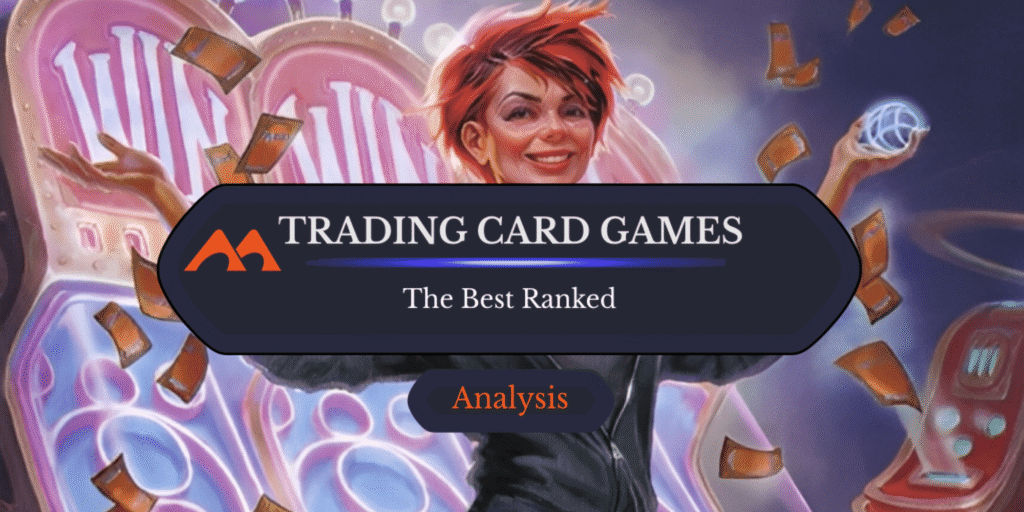
Last updated on April 24, 2025


Standard Procedure | Illustration by Igor Grechanyi
While Magic might be my favorite trading card game, that doesn’t mean that I’m not interested in what else is out there, and I imagine some of you probably feel the same way. Whenever a new trading card game comes out, I’m usually cautiously optimistic about its unique mechanics and design. However, if you play Magic you also know that getting into a new TCG can take time and money, so it’s nice to have some idea if you’ll like the game before you play it.
My goal here isn’t to persuade you to stop playing Magic in favor of another game, or to say you have to try any of the alternatives. This is more a guide if you’re curious what other options might be out there and which are good for what reasons. I’ll be using multiple criteria to rank these games, so if you weigh one of these sections more heavily than others, a game lower on the list might actually be more appealing to you if it’s really good at what you like.
I’m going to be exploring these TCGs from the perspective of both a player and a collector. That means I’ll be ranking games based on how accessible they are to play, how fun they are, and the ways to play. I’ll also be looking at how much cards cost and what, if any value they hold.
What Is a Trading Card Game (TCG)?
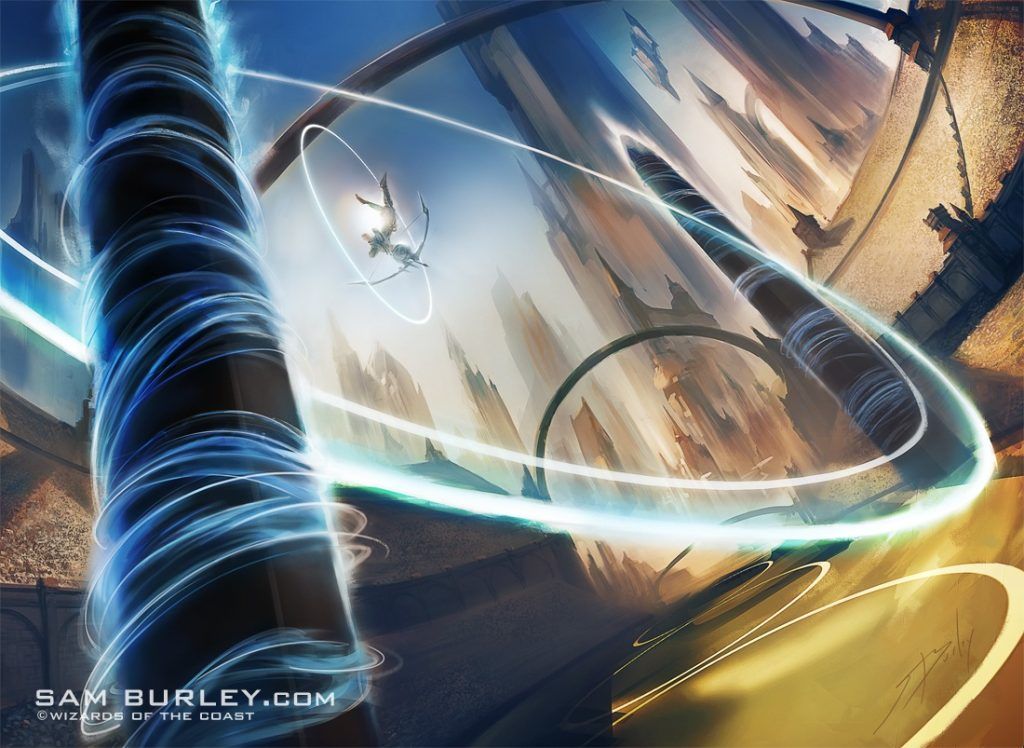

Skygames | Illustration by Sam Burley
A trading card game (TCG) is a game where players build decks to play with from a pool of collectible cards. Because cards are mainly sold in randomized booster packs, these games encourage players to trade with one another in order to create an optimized deck. This often creates a secondary market surrounding the game where players can buy the individual cards they need as opposed to relying on trading or booster packs.
A few things that aren’t trading card games but are similar include: baseball/sports cards, limited card games, deck-building games, and other types of card games that don’t include booster packs. While sports cards are bought in booster packs and have a collectible aspect similar to TCGs, there isn’t a game you can play with them.
Conversely, limited card games or deck-building games may include a main game and expansions, but you always know which cards you’ll get when you buy a product. This means that cards don’t hold individual value in the same way as they do in TCGs because you know you’re guaranteed to get them by buying a specific product. This puts a pretty clear ceiling on how much someone would be willing to pay for an individual card in the game. For similar reasons, other card games like Keyforge that don’t have deck building aspects or booster packs can’t be considered TCGs.
Honorable Mention: The Spoils


The Spoils is an old dead TCG, so I’m not going to be evaluating it by all the same metrics as the games that are still in print. That being said, I wanted to mention it here because it is a lot of fun.
One aspect of The Spoils I thought was great was that it allowed you to play any card in your hand as a resource. This kept you from getting “mana screwed” as frequently as you might in Magic, but prevented the necessity for rules like Yu-Gi-Oh!’s limit on how many monsters you can normal summon in a turn. A similar mechanic is used in Disney Lorcana.
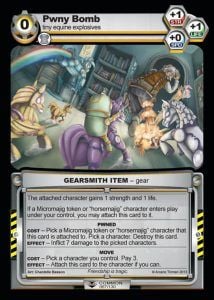

The Spoils also had a very unique look and sense of style. While Magic and other card games have some humor on their cards, they usually aren’t as overtly funny as a lot of the cards from The Spoils were. There were cards like Jacque’s Trap and Pwny Bomb that made opening a pack of cards just a little more fun, even if the cards themselves weren’t the best.
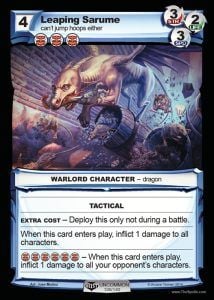

The world of the game had a very grimy feel to it that helped enhance the comedy and also make it stand out in contrast to the more polished look of other card game worlds. This added a lot of texture to the world, as seen in the card Leaping Sarume above.
Some of the jokes are a little dated and off-color, so I can understand someone not enjoying this game as much. That said, I definitely think it’s worth looking into if that doesn’t bother you. It’s also a bit cheaper to buy in large quantities now that the game’s dead.
The Spoils CCG – First Edition Booster Pack [Toy]
- Each 13 card pack contains a random distribution of characters, tactics, gear, items and locations; with one rare, three uncommon, and nine common cards to build your collection and construct superior tournament decks.
Honorable Mention: Yu-Gi-Oh!


I put this game as an honorable mention because in my opinion, it isn’t one of the best TCGs. That said, it has a loyal and dedicated fan base and I understand that my personal opinion isn’t necessarily a popular one when it comes to this game.
Accessibility: Yu-Gi-Oh! is a card game that seems to be in constant flux. Instead of innovating on its core mechanics, the game seems determined to reinvent itself every few years. This makes it difficult to keep up with both from a rules standpoint and for players whose old decks stop being relevant.
Another thing I don’t love about Yu-Gi-Oh! is that there are more rules you need to simply remember that aren’t printed on the cards. For example, you can only normal summon one monster per turn, or if you want to normal summon a level 5-6 monster you need to sacrifice an existing monster as tribute. The more rules that don’t explicitly appear on a card or are referenced by a specific keyword, the more difficulty new players will have keeping track of everything.
A positive aspect of the game is that it can be pretty inexpensive to pick up a starter deck. While these decks aren’t competitive out of the box, if you just want to play with friends you can get some for around $10 which is really good for a TCG.
Fun: Cards on the table, I think I might hate Yu-Gi-Oh! now. It was the first TCG I got into and it used to be a lot of fun, but now games seem to end way too quickly. Turns are longer with a lot more game actions, but when a game ends in 2-3 turns consistently, it often results in a lot of sitting around and waiting for the 40-minute round timer to tick away.
That said, this sort of fast gameplay can actually make Yu-Gi-Oh! appealing if you’re looking for a quicker game to play with friends. Quick turnarounds mean more games and more potential different matchups. If you like card games for the competitive aspect, I think Yu-Gi-Oh! is for you, but it isn’t for me.
Ways to Play: There are four official Yu-Gi-Oh! formats: Advanced, Traditional, Speed Duel, and Common Charity. Advanced allows players to play with any card released, with the exception of some on a ban list. Traditional is rarely played and allows players to use all cards, though some are limited to fewer copies instead of being outright banned.
Speed Duel is a format with altered rules to help new players learn the game, though I contend that it’s kind of harder to get into the game when you have to relearn a bunch of rules just to play the other formats.
The final format is Common Charity, which is basically the same as MTG’s Pauper format. All cards in your deck must have, at one point, been released as a common card.
Another downside to Yu-Gi-Oh! is that it isn’t really draftable. While you technically can, the game isn’t designed for it. This is because synergy is much more important in the game, so there are less generally good cards that can work with a wider range of other cards.
Art: Art is subjective, and I know there are people that love Yu-Gi-Oh!’s art. That said, I think it’s ugly and overdesigned. That’s just me, though. Here are a few examples:






Darklord Zerato reminds me of an ugly Rob Liefeld character, with too many muscles, too many impractical spike bracelets, just all edge no substance. Salamangreat Beat Bison on the other hand is just so busy that I don’t like looking at it for more than a few seconds. It also blends into the background, making it look like a blob of color and therefore less recognizable as a distinct card without reading its text. And then you’ve got your sort of half-baked cards like Penguin Soldier.
Some spell cards have slightly better art, but it’s a big disappointment when the cards that stay on the field longer are also the ugliest ones in the game.
Cost of Cards: There are some pretty valuable collectibles in Yu-Gi-Oh!, usually rare cards from early editions. For example a first edition Blue-Eyes White Dragon or Dark Magician can be worth a pretty penny.
Some newer cards are also pretty expensive too, for example WANTED: Seeker of Sinful Spoils from 2023 is about $90-100. Meta decks range from as low as $40 to as high as $800, so while the game isn’t insane to participate in, it can get pretty pricey at higher levels. Apart from the really rare cards, most Yu-Gi-Oh! cards don’t retain value for too long. This is because the game’s main format doesn’t rotate the way Magic does. Yu-Gi-Oh! relies heavily on new mechanics and power creep, outdating older cards and driving sales of new product. This means, unless your card is very rare and collectible in some way, you aren’t likely to be able to flip your cards if you hold on to them for too long.
#6. One Piece


The One Piece Trading Card Game is fairly new, released as recently as 2022. The basic deck construction has a very Commander feel for those familiar with Magic: The Gathering. Gameplay revolves around a “Leader” card, and the goal is to successfully attack the opponent’s leader to claim victory.
The game has a sort of Hearthstone-style resource system where, unlike Magic, Pokemon, and similar TCGs, the resources you use to play your cards naturally accumulate as turns go by. These “Don!!” cards are necessary to play your character cards, but they’re also used to buff the cards you have in play, and they’re necessary to take certain game actions, creating a balance between playing cards, declaring attacks, and activating abilities that all use the same pool of resources.
Accessibility
One Piece seems incredibly easy to pick up and play. Their official website features an 11-minute tutorial video that walks you through the basics of a match, and honestly that video could be shortened to about 4-5 minutes without all the fluff and filler.
Deckbuilding also seems incredibly easy. Your Leader determines the type of cards you can play the same way a legendary creature determines your color identity in MTG’s Commander format. And unlike games where your main resource is shuffled into your deck, the Don!! cards that act as your resources exist outside your starting deck and accumulate naturally, so the game attempts to eliminate “issues” like mana screw and mana flood, something you see often in non-MTG TCGs like Lorcana.
A cursory look at Amazon shows a variety of Starter Decks, punching anywhere from around $15 on the low end to over $50, so there’s some instability in prices. Generally speaking, starter decks are on the affordable end of the spectrum.
Fun
One interesting element of One Piece is the way in which a player is rewarded when falling behind in a game. Players start with some cards from their deck face-down to represent the life of their Leader, similar to the way Prizes work in Pokemon. If your Leader loses a battle, you’re one step closer to defeat, but you also get to add one of these face-down cards to your hand, essentially gaining a resource in the exchange. It produces a neat little push and pull where sometimes you might not want to take a cheap shot at an opposing Leader because you don’t want to give your opponent extra cards.
Another element that most TCG fans will appreciate is the existence of “counters,” which allow you to take certain actions on an opponent’s turn, usually in response to their declaration of attacks. These often cost Don!! to use, so it’s yet another layer of resource management that comes into effect.
Honestly, the game is overall fairly simple, with the major strategic elements revolving around managing an increasing amount of Don!! each turn. Aside from that curveball, most people already familiar with popular TCGs should be able to pick this game up quickly.
Ways to Play
One Piece is mostly played as a “Constructed” game in which players build their own decks from their own collection of cards, adhering to deckbuilding restrictions (50 cards in deck, match the color of the leader, etc.).
There’s also a Sealed Deck variant in which players open up sealed Booster packs and build decks from the cards they open, ignoring the usual color restrictions on deckbuilding.
The game’s not currently amenable to drafting, though there are house-rule variants floating around that tweak deckbuilding rules to allow for a draftable environment. That said, the game is not currently being produced with a Draft format in mind.
Art
I mean, it’s One Piece. Odds are even if you haven’t been actively watching the anime or reading the manga for the past 15 years or so, you’ve likely encountered some of the main characters through some form of media. And One Piece’s artistic direction is quite divisive for anime fans, with people seemingly loving or hating the anime in particular. This game is an adaptation of that property, so you’ll probably feel the same way about these cards as you do about the show or manga.




There’s nothing wrong with the artistic technique on these cards, it’s just a matter of preference with the actual content. It’s very anime-forward as you’d expect, so take from that what you will.






It does raise the question of longevity, though. How many Monkey D. Luffy cards can you print before everyone’s tired of seeing him? Same for any of the other well-known One Piece characters. Of course, One Piece has a seemingly infinite supply of story to pull from, so that’s more of a long-term problem, if it’s a problem at all. But even with over 1,000 chapters in the manga, how long until the well of characters and plot points runs dry? How long until the art starts to feel repetitive? For non-One Piece fans, probably way sooner than you’d hope. For actual One Piece fans… well, they’re a different breed altogether.
Cost of Cards
One Piece appears to be on the more affordable side of TCGs. A Booster pack runs around $5 (just over $100 for a Booster box), and consensus seems to be that a competitively viable Constructed deck can run around $100, sometimes a little bit more, sometimes less. Compared to games like Yu-Gi-Oh! and Magic: The Gathering, that’s fairly cheap. Base versions of cards also tend to exist within the realm of mortal wallets, though there are expensive chase cards like secret rares and alternate art cards. So there’s something for collectors, but the price for actual players is reasonable.
#5. 2020 Digimon Card Game


Accessibility
First thing’s first, it’s important to recognize that the Digimon TCG got a complete overhaul in 2020, differentiating itself from the previous card game linked to this franchise. For the purposes of this review, I’ll be ignoring the older version completely and focusing on the current rework.
The basic gameplay elements aren’t too far off from what we already explored with One Piece. The goal is to make a single big attack at your opponent, though you have to wear down their defenses first, represented by a stack of cards that go into a sort of “mystery zone” at the beginning of the game. Similar to One Piece, players progress by attacking those cards, which in turn provide benefits to the player being attacked. In other words, there’s a push and pull with winning and losing. If you’re being attacked often, you’re also likely getting benefits from “unlocking” the security cards your opponent had to attack to leave you exposed.
There’s also a Tutorial App available through Google Play that teaches you the basics of the game, so getting started is fairly simple.
Fun


There is one really cool feature of Digimon that feels wholly unique to this card game: The Memory Gauge. Both players share a resource feature ranging from 0-10 on your side, and 0-10 for your opponent (essentially 0 to -10 from your perspective). Playing cards in Digimon involves using memory, and using memory pushes the memory gauge in your opponent’s favor, essentially giving them more resources to work with during their turn. It’s a nice balancing act that lets you make bigger plays at a higher cost, which in turn allows your opponent to make bigger plays.
This allows for some interesting strategizing: Will you play weaker, less memory-intensive cards on your own turn to “choke” your opponent on memory during theirs? Or do you accept the consequences of giving your opponent a bunch of extra memory in order to get your splashier cards into play sooner?
There’s also evolution-style gameplay (digi-volving) for fans of the anime, which essentially lets you upgrade your Digimon over time. It’s similar to the way evolutions work in Pokemon, though it has its quirks and resource requirements specific to this game. There’s a sort of stacking feature here where digi-volving allows you to combine effects from different cards (mutate in MTG, anyone?), so there’s a lot of customization available during gameplay, too.
Ways to Play
Digimon is generally played in a 50-card Constructed 1v1 mode. There’s also an “Egg deck” consisting of five cards that adds an extra element to the game. It’s similar to One Piece in that your main resources (“memory”) don’t actually exist in the deck, so once again we have a game that’s trying to forego any issues similar to mana screw/mana flood in MTG.
Digimon also features a Sealed format where players open new Booster packs and build a deck from what they open. There are some color-matching requirements in the game, so Sealed has just enough variation to make it a repeatable and unique experience each time.
Art
Digimon is and has always been a sort of edgier cousin to Pokémon, so expect a very similar art style with more “dangerous-looking” creatures. It’s very anime-forward, because duh, it’s Digimon, with a general artistic focus on character and creature designs rather than settings or background elements. Those of you familiar with the Yu-Gi-Oh! TCG will note similarities here, with a prominent figure in the foreground, and backgrounds mostly consisting of patterns and design elements rather than any real environmental features.






Similar to Pokémon and One Piece, a lot of Digimon sets explore the same characters in different settings, so there’s a lot of art depicting the same thing in different stances, or with a new physical experience. The game does a pretty good job with this, making the art distinct enough from one named character card to the next.
It’s all preferential here. Many people grew up with the opinion that Digimon was a “rip-off” of Pokémon (or vice versa), and this card game’s not going to change that opinion. If you didn’t like Digimon 20 years ago, you’re not going to like this card game’s art very much either. If Digimon never bothered you, or you were an active fan throughout the years, then the art’s serviceable. It feels directed towards children and young teens, but that’s not a criticism of the art itself, just an observation. If you like bears with cannons on their backs, you’ll probably dig Digimon.
Cost of Cards
A quick look at prices online suggests that Digimon is super cheap, at least for casual players. Starter Decks come in around $10-20, which is highly affordable, especially for anyone who just wants to try the game out, and non-foils from most set releases seem to be under a buck. Booster packs for standard releases have an estimated MSRP of $4.50.
BANDAI | Digimon Card Game: Starter Deck – Wolf of Friendship (ST16) | Card Game | Ages 6+ | 2 Players | 30 Minutes Playing Time
- Unleash the power of Digimon with the Starter Deck Wolf of Friendship ST16, featuring the dynamic duo of Matt and Garurumon.
- This deck is specifically designed to highlight the newest game mechanic, making it the ideal choice for players looking to take their game to the next level.
- With everything you need to get started right out of the box, Digimon Starter Decks provide the perfect entry point for new players.
- Whether you’re a seasoned veteran or just starting out, this deck offers a strategic and exciting gameplay experience that is sure to keep you engaged and entertained.
- So what are you waiting for? Join the Digimon battle today with the Wolf of Friendship ST16 Starter Deck!
Of course, there are expensive chase cards, as there are in any TCG, and competitively viable cards tend to fetch higher prices. Estimations show that you could build a tournament-ready deck for anywhere around $30-$350, so it’s not exactly dirty cheap to participate at a high level, but there’s some wiggle room.
#4. Disney Lorcana


Accessibility: Straightforward rules make Lorcana one of the easier card games to pick up. While there aren’t really too many innovative aspects of the game, that’s a good thing when it comes to ease of access. If you’re somewhat familiar with TCGs you pretty much already know how to play.
Deck construction is pretty easy. You’re limited to one or two colors of cards, and they all use the same resources to be played. This means all you need is a good balance of cards that can be played as resources and a solid curve. The color limit also cuts down significantly on the possible decks that can be built, making it less overwhelming than a game like Magic that lets you mix and match with fewer limitations.
Starter decks are around $20, which isn’t terrible, but boosters are pricey, close to $7-8 a pack. This means if you want to go beyond simply playing out of the box, it’s going to cost you.
Fun: I’ve enjoyed playing Lorcana, but I will say that it often leaves me wanting for more in-depth game play. Whether this is a result of the game being too new to have the complexity of its older competitors or because it wants to stay accessible is hard to say. I can’t give a final verdict on this section until the game has been out longer, but for now I’ll just say it’s enjoyable but not very deep.
Ways to Play: There are currently four tournament formats for Lorcana. Three fall under the Limited category, which includes Draft and Sealed, which are the same as in other card games, and Preconstructed, a tournament where players use only the sealed decks from the game.
The other format is Constructed. Currently, there’s only one Constructed format, but more may be added in the future. Though most tournaments I’ve seen are one-on-one, Lorcana cards are specifically worded to support multiplayer as well. Having played a few multiplayer games, it seems to work pretty well.






Art: The art on Lorcana cards is a mixed bag. The best cards are the ones that take advantage of Lorcana’s premise, that being you’re playing with weird multiversal versions of beloved Disney characters. These cards tend to have the more interesting and stylistic art, like Winnie the Pooh Hunny Wizard or Stitch Rock Star. Unfortunately, these seem to be outnumbered by slightly more generic looking cards and ones like Maleficent Monstrous Dragon that might as well be a retouched screengrab from a movie.
Cost of Cards: The most expensive cards in this game are the premium art versions of cards and the original promos that were released at D23. The nice thing about Lorcana is that if you just want to buy cards for function, the normal art versions top off around $30, with plenty of cards being worth a few dollars or less. This makes deck construction a lot cheaper than some other games, especially if you’re just playing for fun.
Lorcana had a pretty rough start in terms of availability and card prices, though much of that has been hammered out over the last year or so.
Sale
Ravensburger Disney Lorcana TCG: Into The Inklands – Ruby & Sapphire Single-Player Starter Deck | Engaging Gameplay | Over 200 Original Disney Artworks | Ideal for Ages 8+
- ENGAGING GAMEPLAY: Step into the enchanting world of Lorcana with this trading card game- Experience stunning original Disney art while exploring beloved characters- Suitable for casual players and offers depth for the competitive
- INCLUSIVE AND ACCESSIBLE: Designed for 2 or more players aged 8 and up, with gameplay lasting around 10 minutes per player- A welcoming experience for trading card game newcomers and veterans alike
- ORIGINAL ART COLLECTION: Boasting over 200 pieces of breathtaking original Disney art making it the most extensive collection in a single product- Discover this treasure trove of art with every set
- COLLECT AND CHALLENGE: Embark on a journey to build your ultimate deck, collect rare cards, and challenge fellow Disney enthusiasts- Create an extraordinary experience with every game
- HIGH-QUALITY CONTENTS: Each deck contains 60 cards (including 2 foiled), 11 tokens, 1 Rules sheet, and an extra bonus pack of 12 randomized cards- Everything you need to start your Lorcana adventure
#3. Pokemon


Accessibility: I hadn’t played Pokémon in years, so I was pleasantly surprised to find how easy it was to pick back up. One thing Pokemon has going in its favor is that it plays similarly to the video games. If you have any experience with a Pokemon game, learning the card game should be pretty easy. It’s also one of the top three most popular trading card games, along with YGO and Magic.
Pokemon has a range of premade decks that can help you get into the game, starting as low as $10 with the My First Battle decks, with slightly better preconstructed decks coming in around $15-20. I also think the Build & Battle Stadium products can be a fun option if you’re getting into it with a friend, significant other, or sibling. You’ll each get a premade deck and a few boosters to add in cards, which can give you a feel for how upgrading decks works.
Fun: I really enjoyed revisiting Pokemon for this list. Although the game is easy to pick up, it had more depth to it than I was expecting, making me slightly more interested in playing longer than I was with Lorcana. The battles feel like a good length, and the absence of a second main phase definitely kept the action moving.
I will admit some of my enjoyment with this game probably came from my nostalgia for the GameBoy Color days, so if you have no strong ties to Pokemon, you might not have as much fun.
Ways to Play: There are four official Pokemon formats: Standard, Expanded, Theme, and Legacy. Standard is similar to Magic’s version, including the four most recent sets with rotation each year. One cool thing about Pokemon is that they somewhat recently added regulation marks to their cards so you can easily tell which ones are in the current Standard rotation.
Expanded is like Pokemon’s Modern, allowing players to play with about 10 years’ worth of cards. This format has an extensive banned list to prevent any broken combos from ruining it.
Theme is a format where players are given premade themed decks to play with and can’t add cards.
Legacy is interesting; it’s an online-only format and has the biggest card pool. This is Pokemon’s main Eternal format, so it’s kind of a bummer that there aren’t currently in-person events for it.
Pokemon is another game that’s unfortunately not made to be drafted.
Art: Pokemon cards are a bit of a mix when it comes to art. At its worse, some of the cards have the Yu-Gi-Oh! void problem. I noticed this especially on some of the V cards (yes, I know, but that’s what they call them). While it’d be nice to have a more interesting background, the art on the actual Pokemon do make up for it, and stop it from being as ugly as most Yu-Gi-Oh! art.






Some other cards provide a bit more context for where the Pokemon’s natural habitat is, which is definitely a step in the right direction. You can see examples above with Glaceon and Arbok.
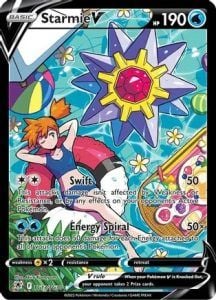

If this was all there was, I’d be disappointed. Luckily, there are some really cool art treatments, one of my favorites being the trainer gallery cards. These depict fan favorite trainers from the games or shows alongside the Pokemon that are known to be on their teams. These cards usually take place in a distinct scene as well, instead of just having a generic background.
Cost of Cards: Pokemon boasts the highest valued card I’ve ever seen from a TCG, the Pikachu-Holo Illustrator promo. There is currently only one copy of the card rated at PSA 10 which the card grading site values at an insane $4 million. Even lower graded versions of the cards are ranked in the hundreds of thousands.
The nice thing about Pokemon is, while some collectibles can be very expensive, actually playing the game isn’t as bad. You can easily find meta decks in the double digit price range, or slightly over $100. This makes Pokemon one of the cheaper games to get into if you want to play more competitively.
Older rare cards have definitely retained a lot of value, as seen by some of the absurdly priced collectibles I already discussed. However, if a card is expensive because it’s good in Standard, then it won’t be valuable for long. Standard rotation in Pokemon happens every year, which is really fast. This means if you aren’t paying close attention to rotation and making sure to dump cards before they lose value, you could probably lose a significant amount of money if you’re treating Pokemon like an investment instead of a game.
#2. Flesh and Blood


Accessibility: I’ve played a lot of Flesh and Blood online and in person, and it’s one of my favorite TCGs. That said, I still feel like I have no idea what’s going on sometimes. The game is incredibly complex, and that’s exactly what I find appealing about it, but it definitely isn’t as beginner friendly as some other TCGs.
As far as price goes, trying out Flesh and Blood if fairly reasonable. You can find some Blitz decks for as little as $10. While there are other TCGs that also have decks at this price, the nice thing about Flesh and Blood decks is that some of these also come with powerful staple cards. The Briar Blitz deck comes to mind as an example.
Fun: One way I can tell a game is truly fun is when I’m enjoying myself even when I’m losing. Despite being somewhat hopeless at the game, I still really love playing Flesh and Blood. I like that decks are built around a specific hero, giving you a very strong attachment to that character in a way you don’t get in Magic even in Commander.
What this game lacks in accessibility it more than makes up for in complexity. Flesh and Blood is very complex on a strategic level which makes it incredibly satisfying when you do manage to pull off a big move. It also means lots of analyzing and tinkering which is one of my favorite parts of a TCG. Another part of the game that I really like is that it was designed specifically to be played in person. This gives it a more old school TCG feel because you get more players testing out new builds at store events, instead of just grinding out on Arena until their deck is perfectly optimized.
Ways to Play: Despite being a relatively new game, Flesh and Blood already has six official formats: Classical Constructed, Blitz, Draft, Sealed, Ultimate Pit Fight, and Blitz Preconstructed.
Classical Constructed is the main way to play, consisting of 80-card decks and using the adult versions of heroes who have more health, making games longer. Blitz is the quicker Constructed format, using young heroes with less health and a smaller deck.
Blitz Preconstructed is the same as Blitz, but instead of building a deck players are only allowed to use the unaltered precons for the format.
Draft and Sealed are the same as in Magic, with one cool change. Because Flesh and Blood is a hero-based game, you don’t draft heroes. Instead you draft your deck and then select one of the heroes from the drafted set to use once you know what cards you have access to.
Ultimate Pit Fight is Flesh and Blood’s multiplayer format. It’s a casual format that uses Blitz rules but allows the use of cards that aren’t normally legal.
Art: The art for Flesh and Blood tends to be really well done. It’s the type of typical fantasy art that borders on the edge of photorealism, but is stylized enough that magical elements don’t look out of place.
Usually I would complain that most of the hero cards are just the character dead center, but that actually works for this game. See, the heroes also appear on a lot of the other cards in your deck, so it works to have a basic hero pose which is then supplemented by images of them doing things. For example, here’s a hero Bravo and one of the attack cards he appears on:




One of my favorite things about Flesh and Blood’s art is how it’s all firmly rooted in the game’s world, similar to Magic. One of my favorites being the card art for Melody, Sing-Along which both sets a scene and captures the essence of the hero.
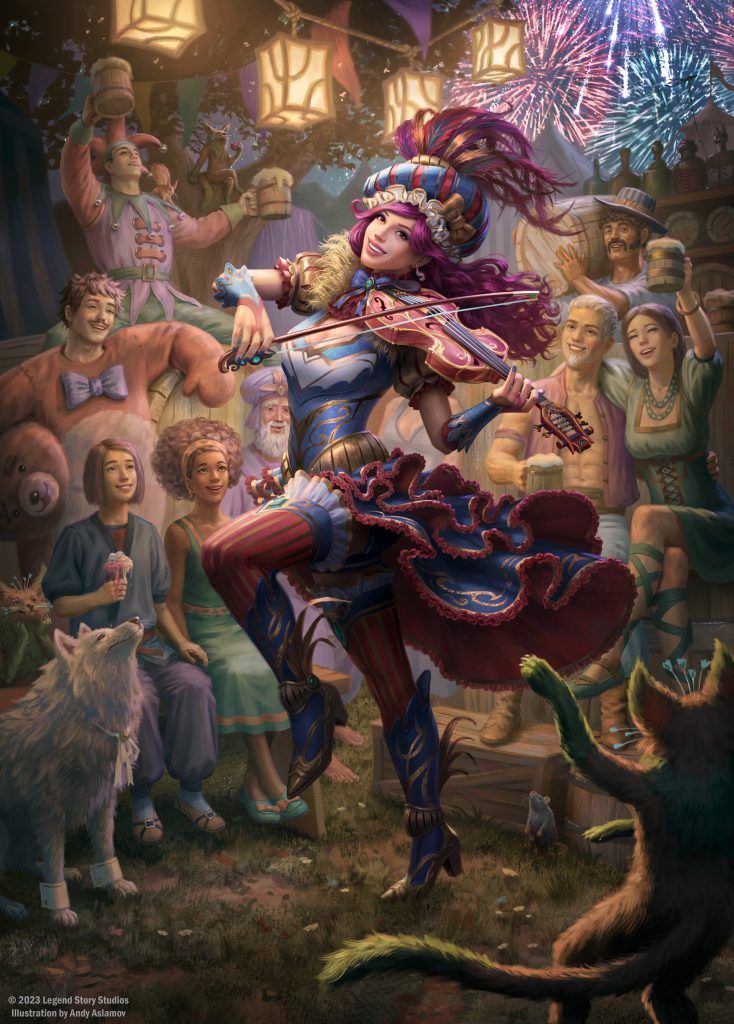

Melody Sing-Along | Illustration by Andy Aslamov
Cost of Cards: Like other TCGs, there are some collectible promos for Flesh and Blood that have made their way up into 5-digit price tags. However, Flesh and Blood does seem to do a decent job keeping good cards affordable if you’re just looking for the cheapest version.
Fyendal’s Spring Tunic is one of the best equipment cards in the game; however, it was reprinted four times within the first 13 expansions. This has helped keep the price more reasonable.
That being said, I won’t pretend Flesh and Blood is cheap. If you want to play casually, you can do so at a reasonable price, but competitive decks can creep up into the thousands of dollars pretty easily.
#1. Magic: The Gathering


Accessibility: Wizards of the Coast tries a lot of different ways to make Magic accessible to new players. One method is the various products that are ready to play out of the box. On the low end for a very casual introduction you have the Starter Kits which come with two decks. Originally these were around $10 but they did unfortunately get more expensive lately. Still, $20 for two decks isn’t bad.
There are also preconstructed decks for a variety of playstyles like Commander, Pioneer, Standard, etc. These products make it easy to get into the game in the specific way you want to.
Magic can be a little more complex than other card games, especially as keyword abilities keep piling up. While this depth appeals to me, it can also make it a little more difficult for new players to feel like they can really be competitive.
Fun: Probably not surprising, but it’s my favorite card game mainly because of how fun it is. It’s complex enough that I feel like I’m still learning more about the game all the time. There’s also a massive card pool which makes deck building a lot of fun, since there are so many options.
Thanks to the popularity of Commander, Magic can also be a very social game, which is something I find lacking in a lot of TCGs. Having the option to sit around the table with a group of friends or even just strangers at the LGS and have a conversation while playing is a nice way to keep the game from always just being competitive.
Ways to Play: Wizards lists over 20 official formats that you can play either on paper or on one of its online clients. I’m not going to go through every single one, but this massive variety means that it’s easy to find a way to play the game how you like it best.
Magic is also the best environment for drafting that I’ve experienced because the design team puts so much care into making sure sets work well for Limited play.
Art: Magic has some of the best artwork of any TCG. It helps that the game has the clout to attract very talented artists with a variety of different styles to contribute to the game. For example, Seb McKinnon’s art on Soulherder. This art is on an uncommon card from an easily accessible set.


Soulherder | Illustration by Seb McKinnon
Not only is the art high quality, but certain sets and planes have distinct looks. Just by looking at Larry MacDougall’s artwork for Sygg, River Guide you can instantly tell that it’s from Lorwyn thanks to the plane’s unique art style.
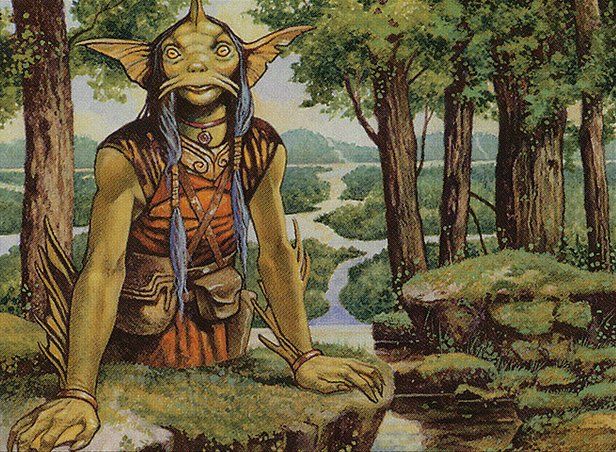

Sygg, River Guide | Illustration by Larry MacDougall
Cost of Cards: If you want a detailed breakdown on the financials of MTG, you should check out our related article for a deeper picture. For a quick overview, Magic can be pretty expensive, especially if you want to play competitively in formats like Legacy or even Modern. That being said, there are cheaper ways to play and plenty of resources for making budget decks, especially for Commander.
On the collectible side of things, the controversial Reserved List can tend to keep prices of certain cards very high. This is good for collectors but can be bad for people who just want access to the functional game pieces.
Want to get started? I definitely recommend going for a preconstructed deck first.
Which TCG is Most Worthwhile for Your Time and Money?
Look, there’s a huge amount of bias here, but the answer is clearly Magic: The Gathering if your primary goal is how much gameplay you’ll get out of the cards you invest in. Magic has so much history, strategic depth, and formatting that cards that rotate out of one format usually have a home somewhere else.
Constructed, tournament-level Magic can be extremely expensive though, so if you’re just looking to minimize the fun-to-money-spent ratio as much as possible, games like Pokemon and Lorcana have a lot to offer. They’re simpler while still maintaining repeatable, fun gameplay.
So if you’re looking for depth and longevity in your game, and money isn’t a primary concern, MTG is the way to go. If you feel “priced out” of Magic, which can certainly happen to some people, or you’re looking for less rules baggage in general, Pokemon and Lorcana are fine alternatives.
Conclusion
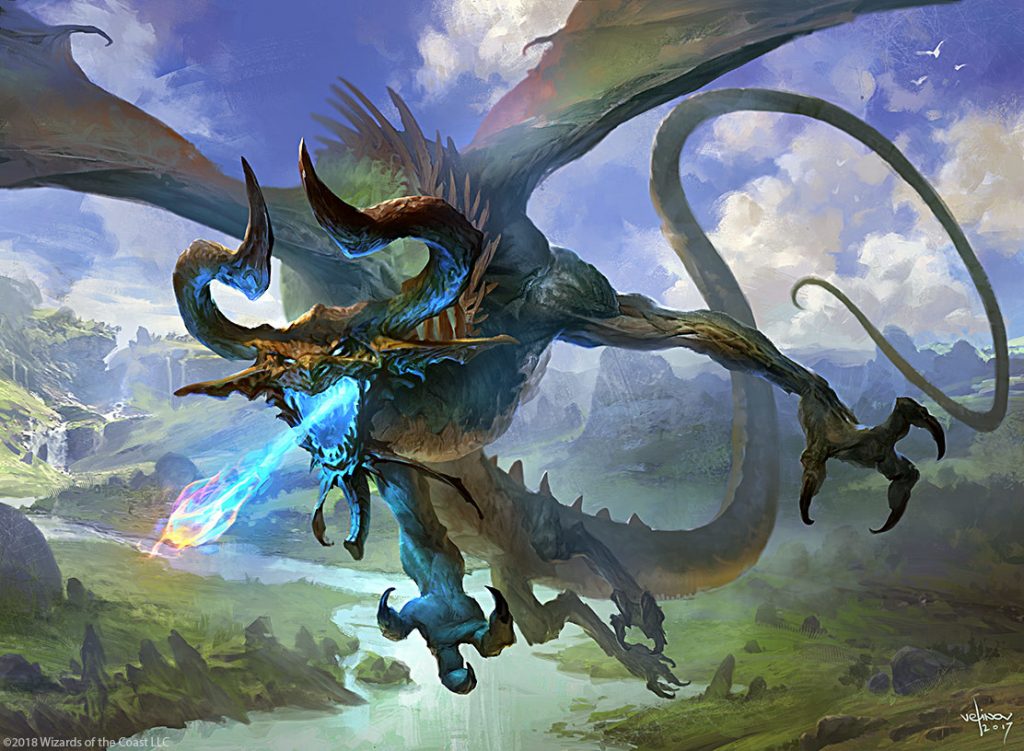

Nicol Bolas, the Ravager | Illustration by by Svetlin Velinov
While Magic is unsurprisingly the #1 TCG that I’ve played, that doesn’t mean you should just stick with it and not test out the others. I would strongly recommend giving Flesh and Blood a try in particular. Something like Disney Lorcana can be a great game to play with the kids in your life since it’s a bit simpler and has the appeal of recognizable characters. Overall, I think most of these games are worth at least trying once.
What other TCGs do you play besides Magic? Any thoughts on Dragon Ball Super or any other games not on this list? Let me know in the comments or on Draftsim’s X.
Thank you for reading and hope this was helpful!
Note: this post contains affiliate links. If you use these links to make a purchase, you’ll help Draftsim continue to provide awesome free articles and apps.
Follow Draftsim for awesome articles and set updates:

![The Spoils CCG - First Edition Booster Pack [Toy]](https://m.media-amazon.com/images/I/417H8+T1jjL._SL160_.jpg)









